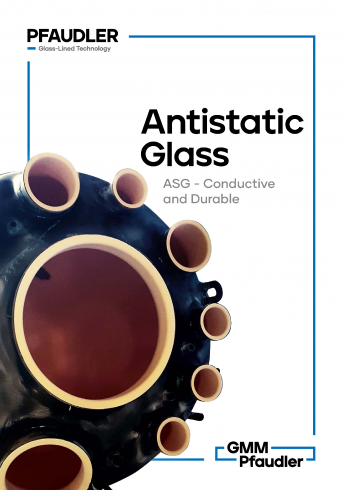ASG : Anti Static Glass
Pfaudler - Glass-Lined & Alloy Systems
Technologies

When is Antistatic Glass (ASG) the correct choice for a process?
Glass-lined vessels fully electrically insulate internal media from the ground. Several substances, including, in particular, the organic solvents used in fine chemical or pharma synthesis, are also non-conductive.
High flow speeds of non-conductive media in non-conductive piping, or through stirring in glass-lined reactors, can lead to electrostatically load the media beyond the dielectric strength of the glass. This then results in electrostatic discharge through the glass layer down to the steel wall. The integrity of the glass layer is undermined.
Pfaudler ASG – Anti Static Glass – is the solution to protect the equipment in these cases.
How ASG glass is manufactured:
ASG glass is a modification of WWG white glass. The glass layers are built up as follows:
- Ground coat and first cover coats are WWG.
- Careful testing of the glass layers and DIN spark test.
- Conductive cover coat including silver nanoparticles.
- Top cover coat with WWG white.
- Conductivity check at 20 kV test voltage: no breakthrough, but response of the test device – no risk of damaging the ASG at 20 kV test.
How ASG glass works:
The discharge of electrostatically loaded media already starts below 1 kV.
- Electrostatic load discharges against the steel wall of the equipment.
- Electrostatic charge flows through the upper glass layer, without damaging it.
- Electrostatic load is distributed over the whole conductive glass layer and discharged through a capacitor effect.
Benefits of ASG glass
- Purity and chemical inertness:
- Surface layer is WWG white, but color of the glass is yellowish. No risk of confusion with other glasses possible.
- No risk of catalytic effect due to any contact with metals, such as platinum.
- No risk of pollution by elements, such as ceramic nanoparticles.
- Conductivity is guaranteed in the range of 1-100 Ohm*cm. The conductive elements of ASG do not undergo all the firing cycles of the glassing process. Consequently, there is no risk of destroying them, and high conductivity can be guaranteed.
- Corrosion resistance: even though corrosion resistance (presence of water) and antistatic (water free) properties are generally not simultaneously required, ASG glass offers the same corrosion resistance as WWG. These simultaneous properties cannot be offered when, for instance, conductive nanoparticles are melted into the glass and undergo all the firing cycles.





